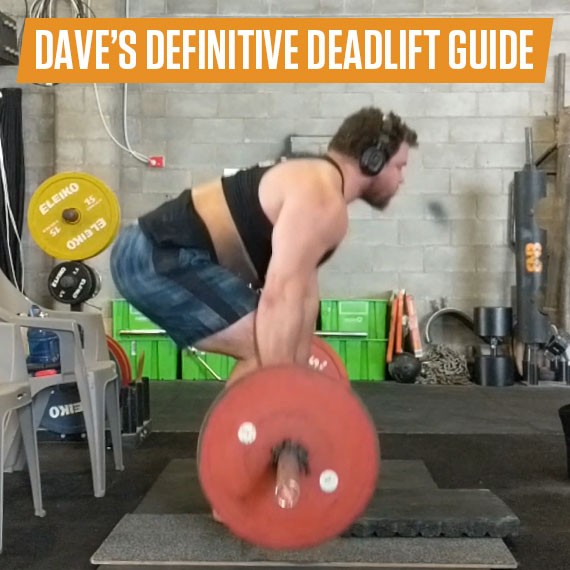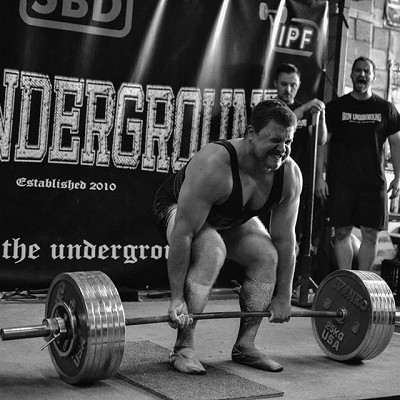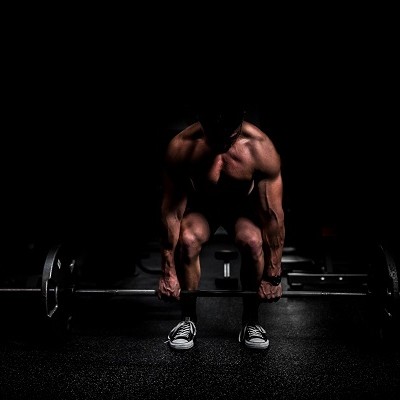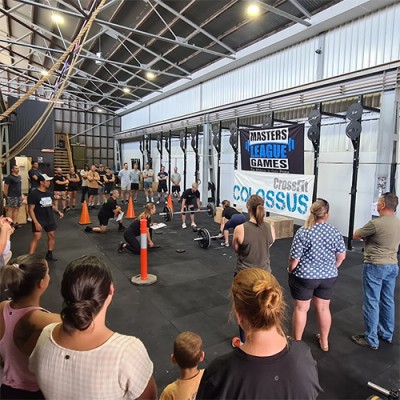Dave's definitive guide to deadlifting variations

The 4 Common Deadlift Variations
Regular Deadlift (conventional style)
The conventional deadlift is usually the first kind of deadlift we all start with at the gym and is the go-to deadlift style for various strength sports from CrossFit to powerlifting. Although it's called the ‘regular’ deadlift, it has a great deal of benefits for building strength, power and muscle. You don’t need a fancy deadlift variation to build strength!
This is a great deadlift for any gym goer or experienced lifter, the conventional deadlift is the best deadlift for anyone new to the gym too and with some technique practise can be mastered. The starting point of this deadlift, the hip height, will vary from lifter to lifter so I suggest using a starting hip height that that results in the best technique for your deadlift.
When deadlifting it's important to stay tight in your starting position (especially in your core and back) and maintain tightness throughout the movement. This will help prevent any rounding of the back and can help prevent injury. Some other tips I have for good deadlift form; maintain a neutral spine (don’t crane your neck), don’t let your hips rise too fast, keep the bar close to your body and avoid overarching your back as you lockout each rep.
The standard deadlift is a beast of an exercise as it targets so many muscles groups, people often say deadlifting is like a full boy workout! The conventional deadlift hits your glutes, quads, hamstrings, calves, lower back, abs and even more! Although the deadlift works so many of your muscles it’s a great compound exercise to start a back workout.
Stiff Leg Deadlift, or Straight Leg Deadlift (SLDL).
I prefer to call these stiff leg deadlifts as most people perform them with a slight bend in the knees due to a lack of flexibility. The goal here is to have the hips high in the air to minimise the amount of quad involvement in the movement and maximise posterior chain usage and engage the glutes, hamstrings, lower back more than a regular deadlift.
Stiff leg deadlifts are great for hitting the hamstrings, and when performed correctly deliver a serious hamstring pump! You can perform this exercise with a loaded barbell or even with a dumbbell or kettlebell in each hand. SLDLs make a great accessory exercise on a lower body and leg day as they can engage the hamstrings so well.
A few tips I have for stiff leg deadlifts are
- Maintain a strong back and core,
- Keep your legs straight or with a very slight bend in the knees if flexibility is an issue as you lower the bar to the floor.
If you’re performing these right, you’ll know it. Feel the burn!
Romanian Deadlift (RDL)
The Romanian deadlift is a deadlift variation that is often performed incorrectly and confused with a stiff leg deadlift, but I’m here to explain exactly how to perform RDLs and why they’re great to add to your workouts.
First, let’s get the technique down pat. Lift from the floor or a rack at lockout height, then perform a stiff leg style deadlift but only lower the bar to approximately knee height or wherever hamstring flexibility stops you from lowering further, this is the major difference between the two variations. With an RDL you don’t reset each rep but hold onto the bar the whole time with each rep starting at the top.
The Romanian deadlift is a great assistance exercise to help build up your regular deadlift and for working your glutes and hamstrings.
Deficit Deadlift
Another great assistance exercise for building a stronger deadlift is the deficit deadlift. Basically, this exercise is completing a deadlift whilst standing from a slight height (on a small box or a weight plate or two stacked up works well).
Why complete a deadlift on a slight height, you may ask?
Well, doing this increases the range of motion and completing deficit work should translate to improved speed off the floor in your regular deadlift.
Deficit height can vary from less than an inch to several inches, the most common height for a deficit deadlift is about two inches.
And there you have it the four most popular variations of the regular deadlift!
Now let's take a closer look at the most common mistakes made in the deadlift and how you can easily fix them...
The 5 common deadlift technique mistakes (and how to avoid them)
If you’re keen to perfect your deadlift, the most important first step is working out what you might be doing wrong. The deadlift isn’t easy to perfect, but with a few adjustments, you can get even more from this lift and prevent unwanted injury too!
Bouncing deadlift reps off the floor
A deadlift should start from a “dead” stop for each rep. This means to let the weight settle on the floor before starting the next rep. Bouncing the bar off the floor gives you momentum and you won’t benefit from the strength-building of pulling the ‘dead' weight from the floor.
There are a few, rare cases where ‘touch and go’ deadlifts can be beneficial, but most people simply use the bounce off the floor to help them bang out more reps but at the expense of not training the movement through the full range of motion.
There are benefits to reset after each rep, it will help you practice your set-up and ensure you are tight and in position each time (you can lose tightness and positioning when bouncing reps). Plus as I said before resetting each rep will help build your deadlift strength faster.
To stop the bouncing habit, I recommend lowering the weight to the floor after your rep and letting it settle before pulling your next rep. Here you can reposition your body into the starting point, take in a deep breath in and pull out the slack before completing the second rep.
Failing to lock out the rep when deadlifting
Locking out a rep is the last part of the rep where your hip come through to ‘lockout’ the rep. This is an important one if you ever want to compete in powerlifting as you need to fully lock out the rep!
Failure to lockout can be due to soft knees (knees should be locked at lockout), hips not extended (stand tall at lockout) or rounded shoulders (shoulders should be neutral or back at lockout, not forwards). In short, try to stand as upright as possible at lockout.
Other tips you might find useful to improve deadlift lockout
- Don’t rush setup - take your time to get into the starting position, get tight and brace your core for the lift
- Use glutes to lockout, not your back – think about tucking in your tail and bringing your hips through (a bit like a hip thrust!)
- Consider working on the top part of the lift by adding in block or rack pulls to your workouts
Hyperextending the lockout
Perhaps you are locking out... but a bit too much! Hyperextending your deadlift lockout is when you overdo the lockout and lean back too far, kind of like you’re playing limbo. This places an excessive amount of stress on the lower back and increases the risk of injury.
The best way to eliminate any overarch is to focus on standing as upright as possible at lockout. Filming your deadlifts can be a good way to see if you are hyperextending.
Rounding the back during the deadlift
This is quite a common mistake made by new lifters but can be easily avoided by nailing down a strong starting position and maintain a neutral spine throughout the lift.
While some upper back rounding during maximal lifting is somewhat unavoidable, the goal should be to maintain a neutral spine as much as possible. Doing this encourages the best possible posture and technique and minimises the risk of injury.
A simple way of helping reduce upper back rounding is ‘head up, chest up, shoulders back’ before you start the lift. You’ll be able to make adjustments as needed by filming your sets and seeing where you go wrong.
“Jerking” the deadlift rep off the floor
The set-up of your deadlift is important for determining how well the rep moves and taking out the slack in the bar should be part of your set-up.
Each rep should be smooth and explosive off the floor, not a sloppy, jerky movement. Try to apply tension to the bar before you lift to help reduce this common mistake. This will help you maintain tightness in your body which will prevent your form from breaking down so you can complete smooth reps time and time again.
The final step of your deadlift setup is to take the slack out of the bar, pull your chest up high and make sure you pull the bar as hard as you can against the weights without pulling it off the floor you basically want the bar to make contact with the top rim of the weight plate. That’s all there is to it!
What muscles do the deadlift actually work?

Dave Napper is a world record breaking personal trainer, nutritionist, powerlifter and business owner.
He is the owner-operator of Brisbane North Barbell, helping to train the next generation of powerlifters and strongmen.
More about Dave NapperRelated Blogs

How to Increase Deadlift Intensity
Posted by Dave Napper
Estimated reading time: 1 minute

What Muscles Do the Deadlift Actually Work?
Posted by Dayne Hudson
Estimated reading time: 6 minutes

CrossFit: Bulk’s Guide to how it stacks up in 2024
Posted by Nick Telesca
Estimated reading time: 16 minutes




























